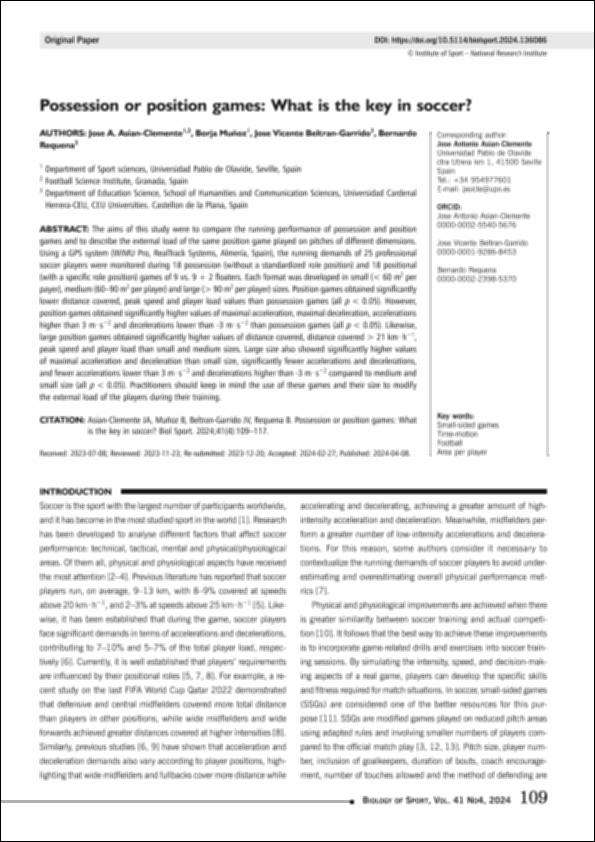Please use this identifier to cite or link to this item:
http://hdl.handle.net/10637/16044Possession or position games: what is the key in soccer?
| Title: | Possession or position games: what is the key in soccer? |
| Authors : | Asian Clemente, José Antonio Muñoz, Borja Beltrán Garrido, José Vicente Requena, Bernardo |
| Keywords: | Fútbol; Soccer; Educación física; Physical education and training; Deporte; Sport; Juegos; Games |
| Publisher: | Institute of Sport - National Research Institute |
| Citation: | Asian-Clemente, J.A., Muñoz, B., Beltran-Garrido, J.V. & Requena, B. (2024). Possession or position games: what is the key in soccer?. Biology of Sport, vol. 41, i. 4, pp. 109–117. DOI: https://doi.org/10.5114/biolsport.2024.136086 |
| Abstract: | The aims of this study were to compare the running performance of possession and position games and to describe the external load of the same position game played on pitches of different dimensions. Using a GPS system (WIMU Pro, RealTrack Systems, Almería, Spain), the running demands of 25 professional soccer players were monitored during 18 possession (without a standardized role position) and 18 positional (with a specific role position) games of 9 vs. 9 + 2 floaters. Each format was developed in small (< 60 m2 per payer), medium (60–90 m2 per player) and large (> 90 m2 per player) sizes. Position games obtained significantly lower distance covered, peak speed and player load values than possession games (all p < 0.05). However, position games obtained significantly higher values of maximal acceleration, maximal deceleration, accelerations higher than 3 m·s−2 and decelerations lower than -3 m·s−2 than possession games (all p < 0.05). Likewise, large position games obtained significantly higher values of distance covered, distance covered > 21 km·h−1, peak speed and player load than small and medium sizes. Large size also showed significantly higher values of maximal acceleration and deceleration than small size, significantly fewer accelerations and decelerations, and fewer accelerations lower than 3 m·s−2 and decelerations higher than -3 m·s−2 compared to medium and small size (all p < 0.05). Practitioners should keep in mind the use of these games and their size to modify the external load of the players during their training. |
| URI: | http://hdl.handle.net/10637/16044 |
| Rights : | http://creativecommons.org/licenses/by/4.0/deed.es |
| ISSN: | 0860-021X 2083-1862 (Electrónico) |
| Issue Date: | 2024 |
| Center : | Universidad Cardenal Herrera-CEU |
| Appears in Collections: | Dpto. Ciencias de la Educación |
Items in DSpace are protected by copyright, with all rights reserved, unless otherwise indicated.


